Physical Address
304 North Cardinal St.
Dorchester Center, MA 02124
Lung cancer is suitable for screening because of identifiable risk factors that allow targeted screening of high-risk individuals, its significant prevalence, the existence of a preclinical phase, its high morbidity and mortality, and evidence that treatment in early-stage disease is potentially curative.
Lung cancer is the third most common cancer in the United States but has the highest mortality rate among cancers. The 5-year survival rate from non–small cell lung cancer (NSCLC) is 16.8%, which is much lower compared with that of other common cancers such as breast cancer (89.2%) and colon cancer (64.7%). The high mortality rate is often due to the diagnosis of lung cancer at an advanced stage. The 5-year survival rate of NSCLC varies from 49% when detected at stage IA to 1% when detected at stage IV. Therefore, early diagnosis would be expected to reduce the mortality rate from this disease.
In 2011, the National Lung Screening Trial Research Group published results from the largest to date, randomized, multicenter study, which included more than 50,000 participants and tested the utility of low-dose computed tomography (LDCT) versus conventional chest radiography (CXR) for lung cancer screening in high-risk individuals. The primary outcome was lung cancer mortality, which was compared between the two arms of the trial. Secondary outcomes included the incidence of lung cancer and causes of death other than lung cancer. There was a relative reduction in the rate of death from lung cancer with LDCT of 20% (95% confidence interval, 6.8–26.7; P = 0.004). The number needed to screen with LDCT to prevent one death from lung cancer was 320. There was a reduction of 6.7% in the rate of death from any cause with LDCT screening ( P = 0.02). The rate of lung cancer detection did not diminish between the screening years. However, fewer stage IV cancers were observed in the LDCT group than the CXR group during the second and third screening rounds, which suggests that the diagnosis of earlier-stage cancers reduces the occurrence of later-stage lung cancers.
Other randomized trials have not demonstrated a mortality benefit; however, these may be too small and therefore underpowered or still preliminary. Several observational studies of LDCT, such as the Early Lung Cancer Project (ELCAP), Mayo Clinic CT study, and Continuous Observation of Smoking (COSMOS) study, have demonstrated that screening with LDCT can identify early-stage asymptomatic lung cancer.
The potential of screening to detect early cancers and increase the overall cure rate can only be achieved in the context of a multidisciplinary program that ensures screening is properly performed, interpreted, and followed up and abnormal findings are appropriately managed.
Unfortunately, because of economic constraints, LDCT screening is directed to those considered to be at highest risk for lung cancer. Tobacco use remains the major modifiable risk factor for lung cancer, with an associated 20-fold relative increase in risk of lung cancer. Smoking cessation markedly reduces the risk of developing lung cancer over time; however, the level of risk never declines to that of a lifetime nonsmoker. Other risk factors for lung cancer include occupational exposures, residential radon exposures, personal cancer history (particularly smoking-related cancers such as head and neck cancers), family history of lung cancer ( Fig. 23.1 ), and chronic lung disease (including chronic obstructive pulmonary disease and chronic interstitial lung disease).
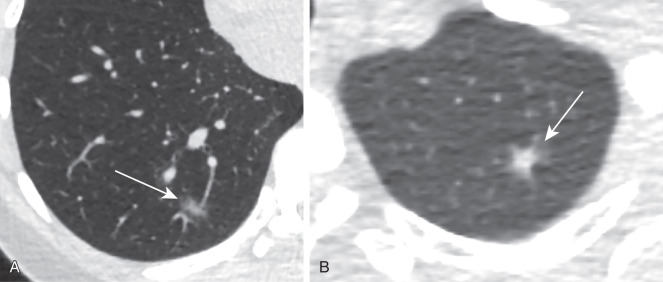
Many professional societies have released screening guidelines based in part on NLST enrollment demographics ( Box 23.1 ). For example, the Centers for Medicare & Medicaid Services covers screening with LDCT once per year in patients who are 55 to 77 years old, asymptomatic, current smokers or have quit smoking within the past 15 years, and have a tobacco smoking history of at least 30 pack-years. However, several other professional societies, including the National Comprehensive Cancer Network and the American Association of Thoracic Surgery, advocate for broader inclusion of at-risk individuals. A retrospective analysis of data from Surveillance, Epidemiology and End results (SEER), the U.S. Census, the 2010 National Health Interview Survey, and two statistical models of lung cancer risk found that only 26.7% of individuals with a diagnosis of lung cancer met NLST screening criteria.
Age
55–77 years (CMS)
55–80 years (USPSTF)
Smoking pack-years
30 (CMS, USPSTF)
Current or former smoker
Years since quitting smoking
15 years (CMS, USPSTF)
Asymptomatic
No signs or symptoms of lung cancer
CMS, Centers for Medicare & Medicaid Services; USPSTF, U.S. Preventive Services Task Force.
A shared decision-making visit between a patient and her or his provider should precede screening. The visit should incorporate discussion of eligibility criteria, the benefits and harms of screening, the likelihood of further diagnostic testing, the risk of overdiagnosis, and false-positive rates. A screening program must also be integrated with a smoking cessation program.
The American College of Radiology (ACR) and Society of Thoracic Radiology have published guidelines regarding how LDCT should be performed for lung cancer screening (see Chapter 1 ). A facility is eligible to receive the ACR Lung Cancer Screening Center designation if it meets a list of basic criteria ( Box 23.2 ).
Shared decision-making visit
Smoking cessation counseling
Screening protocol
A CT dose index volume of <3 mGy for a standard patient
Exposure values must be reduced for smaller sized patients and increased for larger sized patients, using manual or automated methods
Personnel
Interpreting physicians must have read 200 chest CTs in the preceding 36 months
Medical physicists and radiologic technologists continue to meet the requirements of the CT accreditation program
Equipment
CT equipment specifications and performance must meet state and federal requirements and applicable ACR Practice Parameters and Technical Standards
CT scanners used are multidetector helical CT scanners
Follow-up and reporting
Must use structured reporting systems that includes management recommendations
Facilities that accept self-referrals must have procedures for referring them to a qualified health care provider if abnormal findings are present
Follow the ACR Practice Parameter for Communication of Diagnostic Imaging Findings
Data collection and research
ACR, American College of Radiology; CT, computed tomography.
Computed tomography (CT) features that assess the malignant potential of a nodule include its morphology, size, presence of calcification or fat, border, and growth. The ACR has proposed a standardized, comprehensive, clinical decision-oriented system—namely, the Lung CT Screening Reporting and Data System (Lung-RADS) ( Table 23.1 ), which combines a nodule's morphology (solid, part solid, nonsolid) with its average diameter and establishes categories that correlate with risk of malignancy and that determine recommended follow-up protocols. Whereas a screening examination may contain several nodules of varying categories, the overall Lung-RADS score is based on the most suspicious nodule.
| Category | Category Descriptor | Category | Findings | Management | Probability of Malignancy (%) | Estimated Population Prevalence (%) |
|---|---|---|---|---|---|---|
| Incomplete | — | 0 | Prior chest CT examination(s) being located for comparison | Additional lung cancer screening CT images and/or comparison to prior chest CT examinations is needed | N/A | 1 |
| Part or all of lungs cannot be evaluated | ||||||
| Negative | No nodules and definitely benign nodules | 1 | No lung nodules | Continue annual screening with LDCT in 12 mo | <1 | 90 |
| Benign appearance or behavior | Nodules with a very low likelihood of becoming a clinically active cancer because of size or lack of growth | 2 | Nodule(s) with specific calcifications: complete, central, popcorn, concentric rings, and fat-containing nodules | |||
| Solid nodule(s): <6 mm new <4 mm |
||||||
| Part solid nodule(s): <6-mm total diameter on baseline screening |
||||||
| Nonsolid nodule(s) (GGN): <20 mm or ≥ 20 mm and unchanged or slowly growing Category 3 or 4 nodules unchanged for ≥3 mo |
||||||
| Probably benign | Probably benign finding(s): short-term follow-up suggested; includes nodules with a low likelihood of becoming clinically active cancer | 3 | Solid nodule(s): ≥6 to <8 mm at baseline or new 4 mm to <6 mm | 6-mo LDCT | 1–2 | 5 |
| Part solid nodule(s): ≥6-mm total diameter with solid component <6 mm or new <6-mm total diameter |
||||||
| Nonsolid nodule(s) (GGN) ≥20 mm on baseline CT or new | ||||||
| Suspicious | Findings for which additional diagnostic testing or tissue sampling is recommended | 4A | Solid nodule(s): ≥8 to <15 mm at baseline or growing <8 mm or | 3-mo LDCT; PET/CT may be used when there is a ≥8-mm solid component | 5–15 | 2 |
| Part solid nodule(s): ≥6 mm with solid component ≥6 mm to <8 mm Or with a new or growing <4-mm solid component |
||||||
| Endobronchial nodule | ||||||
| 4B | Solid nodule(s) ≥15 mm or new or growing and ≥8 mm | Chest CT with or without contrast, PET/CT and/or tissue sampling depending on the probability b of malignancy and comorbidities; PET/CT may be used when there is a ≥8-mm solid component | >15 | 2 | ||
| Part solid nodule(s) with: a solid component ≥8 mm or new or growing ≥4-mm solid component |
||||||
| 4X | Category 3 or 4 nodules with additional features or imaging findings that increase the suspicion of malignancy | |||||
| Other | Clinically significant or potentially clinically significant findings (nonlung cancer) | 5 | Modifier: may add on to category 0–4 coding | As appropriate to the specific finding | N/A | 10 |
| Prior lung cancer | Modifier for patients with a prior diagnosis of lung cancer who return | C | Modifier: may add on to category 0–4 coding | — | — | — |
A negative screen does not mean that an individual does not have lung cancer.
Size: Nodules should be measured on lung windows and reported as the average diameter rounded to the nearest whole number; for round nodules, only a single diameter measurement is necessary.
Size thresholds apply to nodules at first detection and that grow and reach a higher size category.
Growth: an increase in size of >1.5 mm.
Exam category: Each exam should be coded 0–4 based on the nodule(s) with the highest degree of suspicion.
Exam modifiers: S and C modifiers may be added to the 0–4 category.
Lung cancer diagnosis: After a patient is diagnosed with lung cancer, further management (including additional imaging such as positron emission tomography [PET]/computed tomography [CT]) may be performed for the purposes of lung cancer staging; this is no longer screening.
Practice audit definitions: a negative screen is defined as categories 1 and 2; a positive screen is defined as categories 3 and 4.
Category 4B management: this is predicated on the probability of malignancy based on patient evaluation, patient preference, and risk of malignancy; radiologists are encouraged to use the McWilliams et al assessment tool † when making recommendations.
Category 4X: nodules with additional imaging findings that increase the suspicion of lung cancer, such as spiculation, GGN that doubles in size in 1 year, enlarged lymph nodes, and so on.
Nodules with features of an intrapulmonary lymph node should be managed by mean diameter and the 0–4 numerical category classification.
Category 3 and 4A nodules that are unchanged on interval CT should be coded as category 2 and individuals returned to screening in 12 months.
b Link to McWilliams Lung Cancer Risk Calculator: Upon request from the authors at: http://www.brocku.ca/lung-cancer-risk-calculator At UptoDate http://www.uptodate.com/contents/calculator-solitary-pulmonary-nodule-malignancy-risk-brock-university-cancer-prediction-equation .
Nodule attenuation should be classified as solid or subsolid (part solid and nonsolid). A solid nodule consists of homogeneous soft tissue attenuation ( Fig. 23.2 ). A nonsolid (ground-glass) nodule manifests as hazy increased attenuation in the lung that does not obliterate the bronchial and vascular margins ( Fig. 23.3 ). A part solid nodule consists of both ground-glass and solid soft tissue attenuation components ( Figs. 23.4 and 23.5 ). Although solid nodules are more common, part solid lesions have a higher likelihood of being malignant.
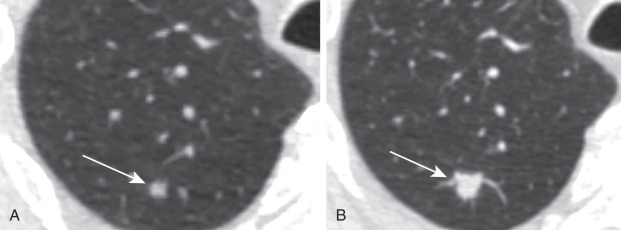
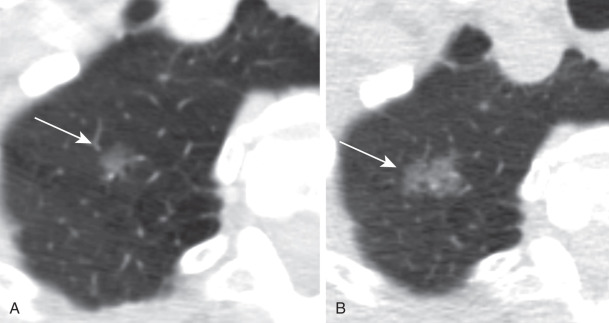
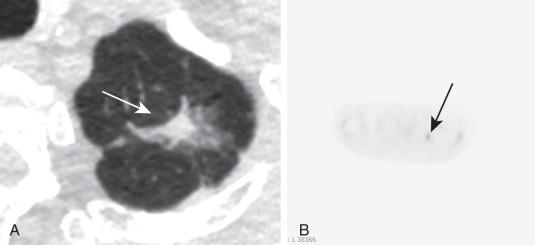
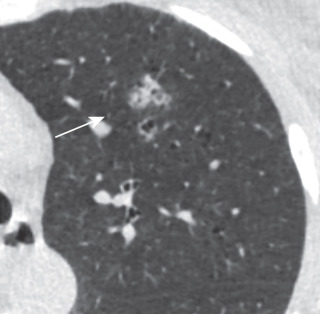
Lung-RADS recommends that nodules and solid components of part solid nodules should be measured on thin sections in the axial plane on lung windows and reported as the average diameter rounded to the nearest whole number. Data from both retrospective series and prospective screening trials show that the risk of malignancy is related to nodule size. The risk of malignancy in a nonsolid nodule that persists beyond 3 months ranges from 10% to 60% and depends on its size and the presence of a solid component.
Become a Clinical Tree membership for Full access and enjoy Unlimited articles
If you are a member. Log in here